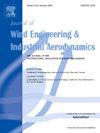Aerodynamic and codification study of low-rise buildings: Part II – Partially elevated structures
IF 4.2
2区 工程技术
Q1 ENGINEERING, CIVIL
Journal of Wind Engineering and Industrial Aerodynamics
Pub Date : 2024-12-01
DOI:10.1016/j.jweia.2024.105925
引用次数: 0
Abstract
This study constitutes part II of an extensive study where the aerodynamics of elevated buildings is investigated using large-scale wind tunnel testing. Part II focuses on the case of elevated buildings with partially enclosed spaces beneath the elevated floor. For this purpose, four 1:10 scaled models of elevated single-story gable-roof buildings were selected, three of which were partially elevated with enclosed regions covering areas ranging from 19% to 54% of the model footprint. The tests aimed to examine the effect of the enclosed regions below the floor on the distribution of the localized peak pressure coefficients on the walls, floor, and roof surfaces of the models. Furthermore, the study evaluates the ASCE 7–22 provisions and the proposed provisions, presented by the authors in Part I, for estimating external wind pressure coefficients acting on the floor, roof, and walls of elevated buildings. The results indicate that enclosed regions below the floor significantly alter the aerodynamics of elevated low-rise buildings and could increase the wind-induced loads on the roof and walls of such structures, with the increase in some cases exceeding 80%. Furthermore, the results align well with the proposed modifications by the authors in Part I to the ASCE 7 provisions for estimating the external pressure coefficients for the various zones of low-rise buildings, addressing the underestimation issues previously identified within the current ASCE standard.
低层建筑的空气动力学和规范研究:第二部分-部分高架结构
本研究是一项广泛研究的第二部分,其中使用大型风洞试验来调查高架建筑的空气动力学。第二部分着重于高架建筑在高架地板下部分封闭空间的情况。为此,我们选择了四个1:10比例的高架单层山墙建筑模型,其中三个是部分高架的,封闭区域覆盖了模型占地面积的19%至54%。测试的目的是检查地板以下的封闭区域对模型的墙壁、地板和屋顶表面的局部峰值压力系数分布的影响。此外,本研究评估了ASCE 7-22条款和作者在第一部分中提出的关于估算作用于高架建筑地板、屋顶和墙壁上的外部风压系数的建议条款。结果表明,地板以下的封闭区域显著地改变了高架低层建筑的空气动力学,并可能增加这种结构的屋顶和墙壁上的风致荷载,在某些情况下增加超过80%。此外,结果与作者在ASCE 7条款第一部分中提出的对低层建筑各个区域的外部压力系数估计的修改意见非常一致,解决了当前ASCE标准中先前确定的低估问题。
本文章由计算机程序翻译,如有差异,请以英文原文为准。
求助全文
约1分钟内获得全文
求助全文
来源期刊
CiteScore
8.90
自引率
22.90%
发文量
306
审稿时长
4.4 months
期刊介绍:
The objective of the journal is to provide a means for the publication and interchange of information, on an international basis, on all those aspects of wind engineering that are included in the activities of the International Association for Wind Engineering http://www.iawe.org/. These are: social and economic impact of wind effects; wind characteristics and structure, local wind environments, wind loads and structural response, diffusion, pollutant dispersion and matter transport, wind effects on building heat loss and ventilation, wind effects on transport systems, aerodynamic aspects of wind energy generation, and codification of wind effects.
Papers on these subjects describing full-scale measurements, wind-tunnel simulation studies, computational or theoretical methods are published, as well as papers dealing with the development of techniques and apparatus for wind engineering experiments.

 求助内容:
求助内容: 应助结果提醒方式:
应助结果提醒方式:


